Saddle Fitting
By Lennard Zinn
Your saddle is your most intimate contact with your bike, and it plays an oversized role in your enjoyment of riding as well as in your health. Saddles come in such a wide range of shapes and sizes, how do you choose among the dizzying array of choices?
Over the years, I have had many people come to me complaining about pain in the rear on their saddle, and I generally have found a solution for them. Usually it involved a different saddle and a different position on the bike. Since it’s such a critical component of bike fit, it’s generally the first thing I address when I do a bike fit with a customer.
First off, getting a saddle that fits your anatomy correctly is key to comfortable seated pedaling. The primary fit parameter is the matching of saddle width to the spacing between the sit bones. Additionally, saddle shape and the gender, age, riding style, bike type, and bike position of the rider all also play important roles.
- Saddle width
The first step to determining proper saddle fit is to accurately measure the distance between the sit bones (ischial tuberosities). You can imagine the difficulty in measuring this dimension with a ruler. You’ve got to have the proper tool!
Specialized saddle dealers have devices for measuring for sit-bone width: either a small memory-foam one (Fig. 1, bottom, lovingly called an Ass-O-Meter) or a digital pressure-sensitive screen (the Digital Sitbone Device, or DSD). The rider sits on the device on a low bench with the knees higher than the hips to press their ischial tuberosities into the memory foam or the pressure-sensitive screen. The distance between the centers of these impressions is the sit bone width.
Similarly, an SQ-Lab saddle dealer (like Zinn Cycles) will have a fit bench with a plastic plate on top arrayed with sharp spikes (Fig. 1, top). The dealer places a piece of paper over the spikey rectangular plate, and the rider sits on it with their heels on the bar on the bench legs so the knees are higher than the hips. The rider also grabs the edges of the bench and pulls themselves down to further press their sit bones into the paper. The spikes perforate the paper in the region of highest pressure. The distance between the centers of the perforated areas is the sit bone width.
You can get a similar impression of your sit bones by peeling the paper layer off one side of a piece of corrugated cardboard. Place it on a low bench with the corrugations facing up. Sit on it with your knees higher than your hips. Measure the distance between the centers of the two sit-bone impressions.
Fig. 1: Sit-bone-spacing measuring devices: Top, SQ-Lab saddle-fit bench; Bottom, Specialized memory-foam Ass-O-Meter
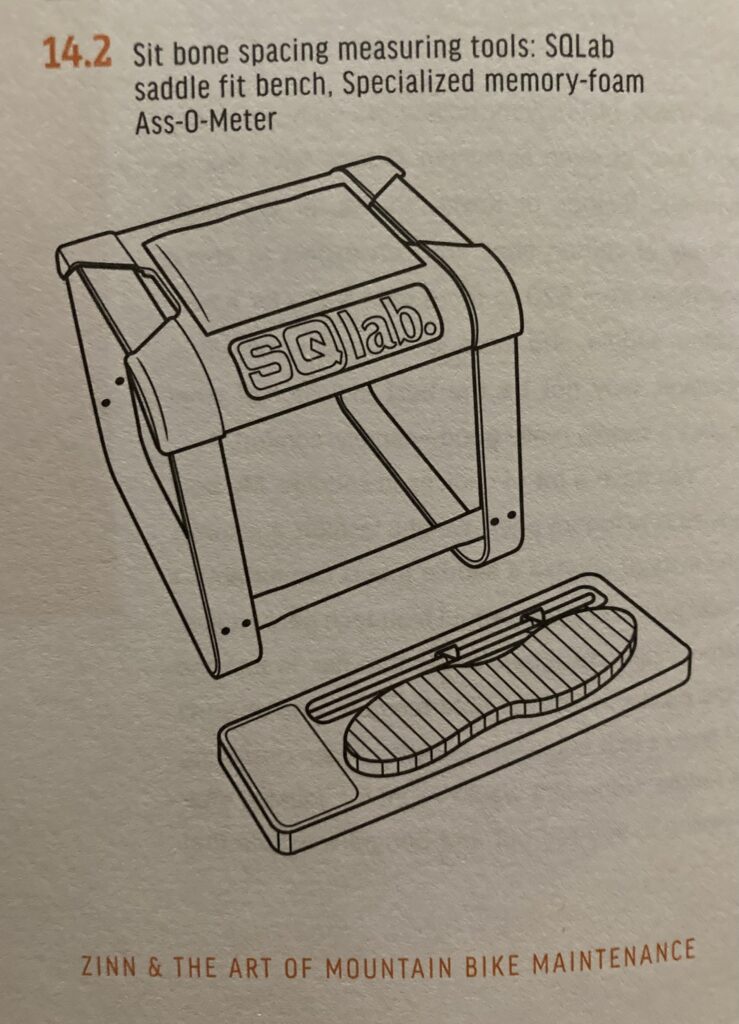
The purpose of measuring sit-bone width is to ensure that the sit bones are fully supported upon the saddle and that the saddle is also not wider than the rider needs. If the sit bones are perched at or, worse, over the saddle edges, the saddle will compress the nerves and blood vessels that pass inboard of the sit bones, resulting in numbness and blood flow reduction, the latter in some cases leading over time to male impotence. If, on the other hand, the sit bones are too far inboard from the saddle edges, then the wings of the saddle will impede the hamstring muscles on the downward stroke and cause the rider’s pelvis to bounce up and down on the saddle at high pedaling cadence.
The ideal saddle width for a standard riding position for road, gravel, cross-country MTB, and cyclocross riding is 2cm wider than the sit-bone width. Depending on the shape of the saddle, you generally want this 2cm additive to be the minimum.
For example, if the centers of a rider’s sit bones are 120mm apart, then a saddle whose greatest width is 140mm will be recommended. Specialized saddles come in 135, 143, 155, and 168mm widths, so the choice in this case would be 143mm. SQ Lab saddles come every 1cm increment (Photo 1), so a 14cm would be the correct size. If the sit bones are 125mm apart, then either a Specialized 143mm or 155mm might work, and in SQ Lab, a 15cm would be the choice.
Photo 1: SQ-Lab Ergowave 60X saddle widths. All SQ-Lab saddles are available in 1cm width increments.
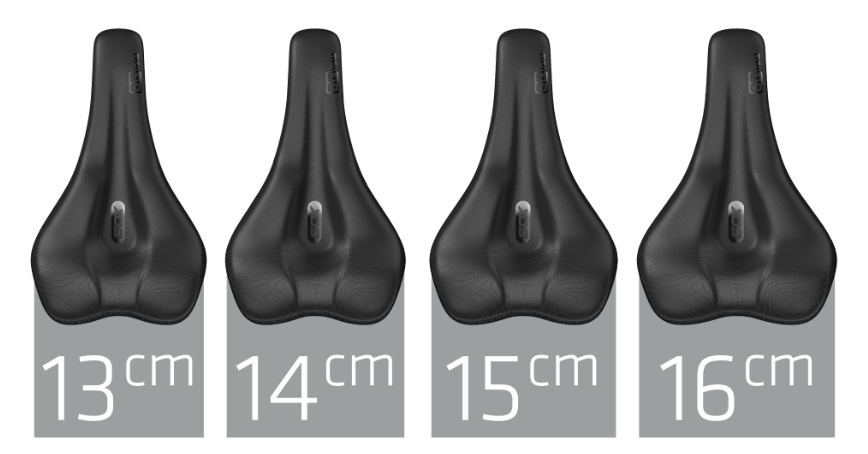
Upright riding positions favor wider saddles yet. More weight is borne on the sit bones and less on the hands, so a wider, more padded platform for the sit bones tends to improve saddle comfort. In that case, adding 3-4cm to the sit bone width is recommended.
Conversely, super low, aero riding positions—like for racing in triathlons and time trials (see c., below)—result in the rider’s pelvis being rotated so far forward that the ischial tuberosities don’t even contact the saddle, so the saddle’s width in the rear has minimal relevance.
- Saddle shape
Due to scares about erectile dysfunction and prostate disease among male cyclists, performance saddles went from being narrow and rounded to availability in a range of widths with a flat area in the back to support the sit bones and a valley or open split down the middle to reduce or eliminate pressure on the blood vessels and soft tissue of the perineum (Fig. 2). The padding on soft, heavily-padded saddles, tends to press up between the sit bones and compress perineal nerves and arteries in the same way that a narrow, overly-curved saddle can. Thus, the padding tends to be thin and dense on performance road, gravel, cross-country, or cyclocross bikes.
Fig. 2: Fizik Vento Antares performance saddle featuring central pressure-eliminating open split, flat rear platform and thin, dense padding
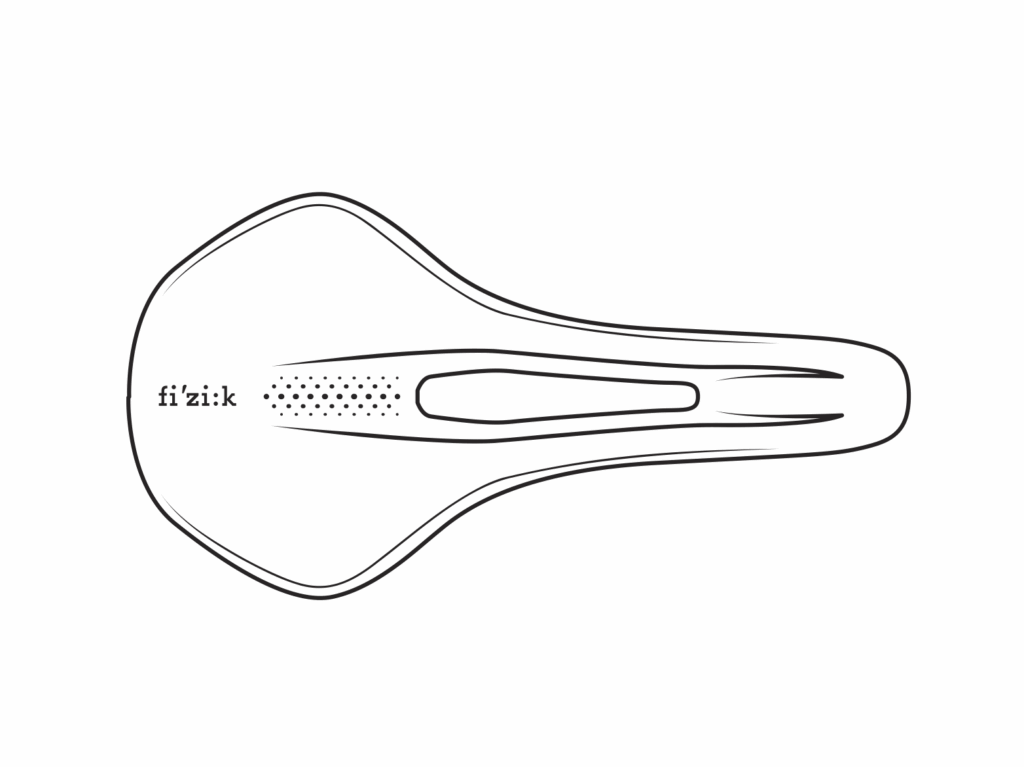
While performance saddles tend to be designed by and for males, studies by Specialized of competitive female cyclists logging huge riding mileage indicate that the female anatomy does not benefit in the same way as male anatomy from an open split down the middle of the saddle. Where male genitals tend to shrink with saddle pressure, female labia tend to become engorged with blood and swollen after long hours on a saddle of this type, leading to discomfort and even long-term damage requiring surgical intervention. Specialized’s answer to this is its MIMIC technology, which utilizes multilayered soft, stretchy materials bridging the opening in the saddle nose to maintain equilibrium pressure and minimize swelling in female perineal tissue (Fig. 3).
Fig. 3: Specialized Power Arc saddle with soft, stretchy MIMIC feature in the depression in the saddle nose
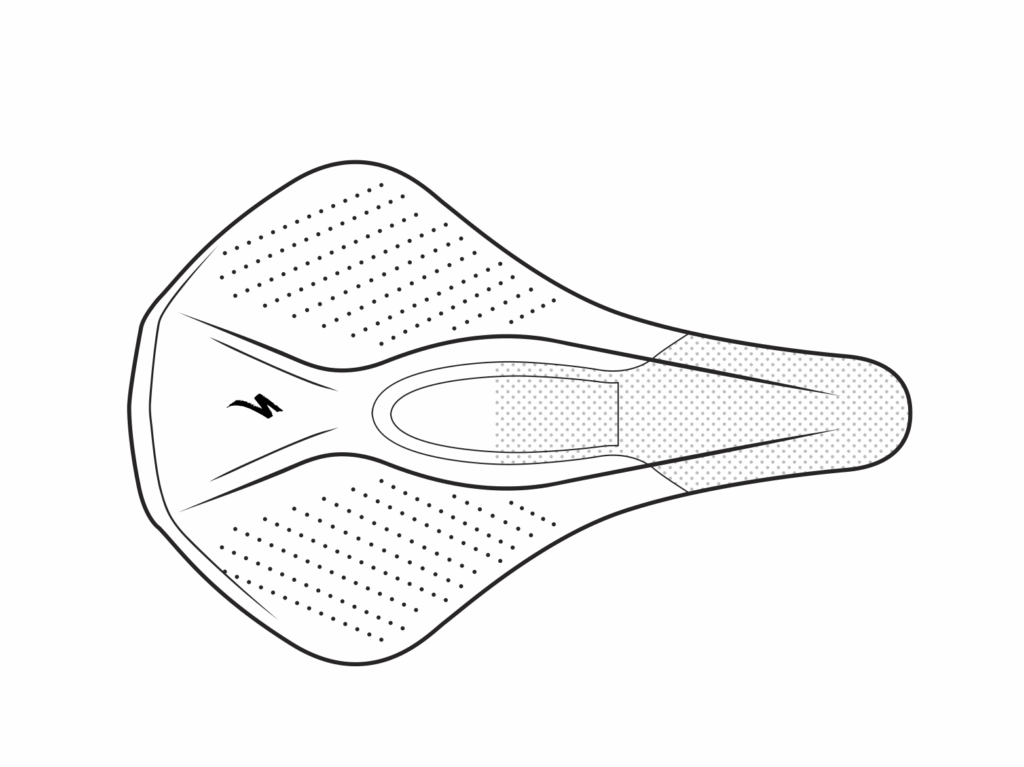
Most Specialized Mirror saddle models, which are 3D-printed in an open matrix intended to “mirror” the rider’s physiology (Fig. 6), also have this MIMIC hammock-like central feature, but as a stretchy, open honeycomb.
Fig. 6: Specialized Phenom Mirror saddle with soft, stretchy, honeycomb MIMIC feature in the depression in the saddle nose
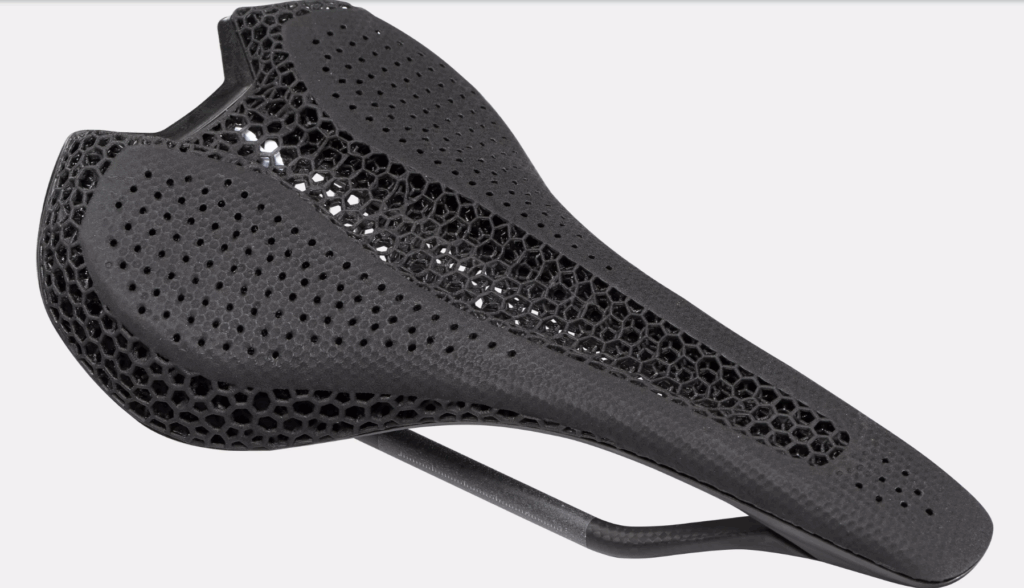
- Aero Positions
Saddles for aero bikes are completely different than the above saddles. The inferior pubic rami forming the bottom of the pelvis angle inward from the ischial tuberosities forward toward their meeting point at the pubis. So, as the rider’s pelvis tips further forward to bring the torso into a more aerodynamic position, where his or her pelvis contacts the saddle narrows, and there will be no need for a saddle that is wide in back. If the rider’s shoulders are so low that the back is horizontal, which can only realistically be achieved with a far-forward saddle position so that the thighs don’t hit the torso, then the saddle width need not be wider than the sit-bone width.
In that far-forward-saddle, horizontal-back, aero position of competitive triathletes and time trialers, the pressure caused by the forward tilt of the pelvis on a typical saddle nose can be not only uncomfortable but also injurious to the soft tissues of the perineum over the long term. For many triathletes and time trialers, ISM’s open-nose, horseshoe-shaped performance saddles are the go-to solution for this issue (Fig. 7); on it. The pressure is on the inferior pubic rami on either side of the soft tissue of the perineum, which sits in the void between the twin arms of the saddle nose. The Specialized Sitero and Fizik Transiro Aeris are alternative examples of saddles offering similar support yet still reconnecting in front of and below the large split down the middle. These and other saddles for aero time trial and triathlon bikes tend to be short, partly to skirt UCI regulations limiting how far forward the tip of the saddle can be relative to the cranks for road racing.
Fig. 7: ISM PS 1.0 CR time trial/triathlon saddle

- Individual Preferences
There is a plethora of saddles of different shapes and construction on the market to meet different personal needs and preferences. People’s pelvises are not only shaped differently, they also are tipped forward or back differently once on a bike. Thus, the shape, cushioning, and curvature of the rear of the saddle and the width, length, and padding of the saddle nose are items of personal preference. Experimentation may be necessary to find the right saddle for you. At Zinn Cycles, we offer limited-time, no-cost exchanges of saddles so that you can do this experimentation and find the right saddle for you.
Your enjoyment on the bike and the long-term health of your undercarriage depend on a saddle that supports you properly and doesn’t irritate you, cause swelling, cut off blood flow, or cause numbness, so don’t accept discomfort. And if your beloved saddle that has worked great for you for years stops feeling so wonderful, be open to switching to a different one as your body, position on the bike, and riding style change with passing years.
As a frame builder, Lennard Zinn has been designing and building custom bicycles for over 42 years; he founded Zinn Cycles in 1982 and co-founded Clydesdale Bicycles in 2017. His Tech Q&A column on Substack follows his 35-year stint as a technical writer for VeloNews (from 1987 through 2022). He is a former U.S. National Cycling Team member and author of many bicycle books including Zinn and the Art of Mountain Bike Maintenance, Zinn and the Art of Road Bike Maintenance, and The Haywire Heart. He holds a bachelor’s degree in physics from Colorado College.
Follow Lennard Zinn on Substack, Strava, X, Instagram, LinkedIn, or Facebook.


